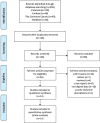A systematic review and meta-analysis of perforator flaps in plantar defects: Risk analysis of complications
- PMID: 33675188
- PMCID: PMC8273610
- DOI: 10.1111/iwj.13552
A systematic review and meta-analysis of perforator flaps in plantar defects: Risk analysis of complications
Abstract
The purpose of this study was to identify the risk factors for complications of perforator flaps in plantar reconstruction. A systematic review was performed by searching the PubMed, Cochrane Library, MEDLINE, and EMBASE databases from their inception date up to October 2020. Only studies on reconstructing plantar defects with perforator flaps were included, and specific data were required for each patient in the included studies. A total of 14 studies involving 111 flaps were identified and included in the meta-analysis. Our meta-analysis identified two risk factors for postoperative complications: flap size over 50 cm2 (risk ratio [RR] = 3.12; P = .02), diabetes mellitus foot (RR = 3.26; P = .03). No significant differences were found regarding heel defects (P = .34), single perforator (P = .57), age older than 60 years (P = .19), chronic aetiology (P = .13), trauma (P = .33), tumour resection (P = .60), ulcer (P = .84), and burn (P = .76). Although more high-quality studies with adequate sample sizes are needed, this meta-analysis indicated that flap size over 50 cm2 and diabetes mellitus foot were significant risk factors for postoperative complications of perforator flaps in plantar reconstruction.
Keywords: complication; meta-analysis; perforator flap; plantar defect; risk factor.
© 2021 The Authors. International Wound Journal published by Medicalhelplines.com Inc (3M) and John Wiley & Sons Ltd.
Conflict of interest statement
The authors declare that there is no conflict of interest.
Figures










Similar articles
-
Reconstruction of the Heel, Middle Foot Sole, and Plantar Forefoot with the Medial Plantar Artery Perforator Flap: Clinical Experience with 28 Cases.Plast Reconstr Surg. 2018 Jan;141(1):200-208. doi: 10.1097/PRS.0000000000003975. Plast Reconstr Surg. 2018. PMID: 28938363
-
[Application of the plantar horn shaped fasciocutaneous perforator flaps for the reconstruction of the defects on heel and fore plantar].Zhonghua Zheng Xing Wai Ke Za Zhi. 2013 Sep;29(5):341-4. Zhonghua Zheng Xing Wai Ke Za Zhi. 2013. PMID: 24409774 Chinese.
-
Medial plantar artery-based perforator and island flaps: a case series of applications in sole defects.J Wound Care. 2022 Feb 2;31(2):130-138. doi: 10.12968/jowc.2022.31.2.130. J Wound Care. 2022. PMID: 35148628
-
Distally based perforator flaps for reconstruction of post-traumatic defects of the lower leg and foot. A review of the anatomy and clinical outcomes.Injury. 2014 Mar;45(3):469-77. doi: 10.1016/j.injury.2013.09.003. Epub 2013 Sep 10. Injury. 2014. PMID: 24075220 Review.
-
Is the Medial Sural Artery Perforator Flap a New Workhorse Flap? A Systematic Review and Meta-Analysis.Plast Reconstr Surg. 2019 Feb;143(2):393e-403e. doi: 10.1097/PRS.0000000000005204. Plast Reconstr Surg. 2019. PMID: 30531631
Cited by
-
Role of microsurgical free flap reconstruction in managing complex wound: a retrospective cross-sectional study.Pan Afr Med J. 2022 Dec 30;43:211. doi: 10.11604/pamj.2022.43.211.36595. eCollection 2022. Pan Afr Med J. 2022. PMID: 36974316 Free PMC article.
-
Application of supraclavicular island flap in oral and maxillofacial reconstruction.Oral Maxillofac Surg. 2024 Jun;28(2):893-908. doi: 10.1007/s10006-024-01225-2. Epub 2024 Feb 14. Oral Maxillofac Surg. 2024. PMID: 38355871
-
An animal experiment study on the application of indocyanine green angiography in the harvest of multi-angiosome perforator flap.Ann Transl Med. 2022 Feb;10(4):197. doi: 10.21037/atm-22-220. Ann Transl Med. 2022. PMID: 35280416 Free PMC article.
References
-
- Wang M, Xu Y, Wang J, et al. Surgical Management of Plantar Melanoma: a retrospective study in one center. J Foot Ankle Surg. 2018;57(4):689‐693. - PubMed
-
- Löfstrand JG, Lin C. Reconstruction of defects in the weight‐bearing plantar area using the innervated free medial plantar (instep) flap. Ann Plast Surg. 2018;80(3):245‐251. - PubMed
-
- Scaglioni MF, Rittirsch D, Giovanoli P. Reconstruction of the heel, middle foot sole, and plantar forefoot with the medial plantar artery perforator flap. Plast Reconstr Surg. 2018;141(1):200‐208. - PubMed
-
- Koshima I, Soeda S. Inferior epigastric artery skin flaps without rectus abdominis muscle. Br J Plast Surg. 1989;42(6):645‐648. - PubMed
Publication types
MeSH terms
LinkOut - more resources
Full Text Sources
Other Literature Sources
Medical

